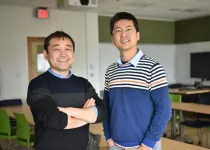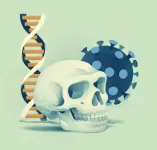(Press-News.org) As most of us learned in school, plants use sunlight to synthesize carbon dioxide (CO2) and water into carbohydrates in a process called photosynthesis. But nature's "factories" don't just provide us with food -- they also generate insights into how ecosystems will react to a changing climate and carbon-filled atmosphere.
Because of their ability to make valuable products from organic compounds like CO2, plants are known as "primary producers." Gross primary production (GPP), which quantifies the rate of CO2 fixation in plants through photosynthesis, is a key metric to track the health and performance of any plant-based ecosystem.
A research team with the U.S. Department of Energy's Center for Advanced Bioenergy and Bioproducts Innovation (CABBI) at the University of Illinois Urbana-Champaign developed a product to accurately measure GPP: the SatelLite Only Photosynthesis Estimation Gross Primary Production (SLOPE GPP) product at a daily time step and field-scale spatial resolution.
The team leveraged the Blue Waters supercomputer, housed at the U of I National Center for Supercomputing Applications (NCSA), in their research. Their paper was published in Earth System Science Data in February 2021.
"Quantifying the rate at which plants in a given area process CO2 is critical to a global understanding of carbon cycling, terrestrial land management, and water and soil health -- especially given the erratic conditions of a warming planet," said Kaiyu Guan, project leader and NCSA Blue Waters Professor.
"Measuring photosynthesis is especially pertinent to agricultural ecosystems, where plant productivity and biomass levels are directly tied to crop yield and therefore food security. Our research directly applies to not only ecosystem service, but also societal well-being," said Chongya Jiang, a research scientist on the project.
Of particular intrigue is the relevance of GPP monitoring to bioenergy agricultural ecosystems, where the crops' "factories" are specially designed to produce renewable biofuels. Quantifying CO2 fixation in these environments is instrumental to optimizing field performance and contributing to the global bioeconomy. CABBI scientists, such as Sustainability Theme researcher Andy VanLoocke, suggest that this critical new data can be used to constrain model simulations for bioenergy crop yield potentials.
The technology used in this experiment is cutting-edge. As its name suggests, it is purely derived from satellite data, and therefore completely observation-based as opposed to relying on complex, uncertain modeling methods.
One example of an observation-based technology is solar-induced chlorophyll fluorescence (SIF), a weak light signal emitted by plants that has been used as a novel proxy for GPP. Inspired by their years-long ground observations of SIF, Guan's group developed an even more advanced method to improve GPP estimation: integrating a new vegetation index called "soil-adjusted near-infrared reflectance of vegetation" (SANIRv) with photosynthetically active radiation (PAR).
SLOPE is built on this novel integration. SANIRv represents the efficiency of solar radiation used by vegetation, and PAR represents the solar radiation that plants can actually use for photosynthesis. Both metrics are derived from satellite observations.
Through an analysis of 49 AmeriFlux sites, researchers found that PAR and SANIRv can be leveraged to accurately estimate GPP. In fact, the SLOPE GPP product can explain 85% of spatial and temporal variations in GPP acquired from the analyzed sites -- a successful result, and the best performance ever achieved benchmarked on this gold-standard data. As both SANIRv and PAR are "satellite only," this is an achievement that researchers have long been seeking but is just now being implemented in an operational GPP product.
Existing processes to quantify GPP are inefficient for three key reasons: spatial (image-based) precision, temporal (time-based) precision, and latency (delay in data availability). The SLOPE GPP product created by Guan's team uses satellite images twice as sharp as most large-scale studies (measuring at 250 meters versus the typical >500 meters) and retrieves data on a daily cycle, eight times finer than the norm. More importantly, this new product has between one and three days latency, whereas existing datasets lag behind by months or even years. Finally, the majority of GPP products employed today are analysis- rather than observation-based -- the metrics they use to calculate GPP (e.g., soil moisture, temperature, etc.) are derived from algorithms rather than real-world conditions gleaned from satellite observations.
"Photosynthesis, or GPP, is the foundation for quantifying the field-level carbon budget. Without accurate GPP information, quantifying other carbon-related variables, such as annual soil carbon change, is much less reliable," Guan said. "The Blue Waters supercomputer made our peta-bytes computing possible. We will use this novel GPP data to significantly advance our ability to quantify agricultural carbon budget accounting, and it will serve as a primary input to constrain the modeling of soil organic carbon change for every field that requires soil carbon quantification. In addition to the SLOPE GPP data, similar methods allow us to generate GPP data at 10-meter and daily resolution to even enable sub-field precision agricultural management."
INFORMATION:
The SLOPE GPP data from 2000-2019 is archived under a Creative Commons Attribution 4.0 license and is publicly available at NASA's Oak Ridge National Laboratory Distributed Active Archive Center. Download the data here or access using the DOI at https://doi.org/10.3334/ORNLDAAC/1786.
In addition to their CABBI research roles, Jiang and Guan are affiliated with the Agroecosystem Sustainability Center (ASC), Institute for Sustainability, Energy, and Environment (iSEE), and the College of Agricultural, Consumer and Environmental Sciences (ACES) at Illinois. The study's co-authors are Ph.D. Candidate Genghong Wu, ASC, CABBI and ACES; Research Scientist Bin Peng, ASC, NCSA and ACES; and Research Scientist Sheng Wang, ASC, CABBI and ACES. The project is partially funded by the NASA Carbon Monitoring System and NSF Environmental Sustainability Program. Blue Waters is supported by the National Science Foundation and National Geospatial Agency.
Correspondence to: Chongya Jiang
(chongya.jiang@email.com) and Kaiyu Guan
(kaiyuguan@gmail.com)
Read the full publication in Earth System Science Data.
DAVIS, Calif., Feb 16, 2021 - Researchers publishing in the peer-review journal Frontiers in Pediatrics report that pre-term infants fed Bifidobacterium longum subsp. infantis (activated B. infantis EVC001) experienced significantly lower level of intestinal inflammation, 62% less diaper rash, and required 62% fewer antibiotics- all of which are critical health indicators in neonatal care.
The study, END ...
A pair of UCR studies reveal that living with a romantic partner helps people feel more socially connected during COVID-19. But no other pandemic-era social dynamic carries notable benefits, the researchers found: not your kids, not kibitzing with your bestie on Facetime, and not your adorable-adoring pets.
"Research prior to the pandemic has long shown that partners are one of the strongest predictors of social connection and well-being," said UCR researcher Karynna Okabe-Miyamoto, lead co-author of the study, published recently in the journal Plos One. "And our research during the current COVID-19 pandemic has shown the same. Living with a partner uniquely buffered declines in social ...
Findings from a new Geisel-led study, published in the Journal of General Internal Medicine, reveal that there is substantial variation across different regions of the country in the intensity of fracture-associated drug (FAD) use among long-term care facility residents, and that areas with greater use of these prescription drugs experience higher hip fracture rates.
In recent decades, the use of prescription medications has increased dramatically in the U.S. due to factors such as improvements in the ability to detect disease, expanding treatment options, and an aging population. For many Americans over age 65, these medications provide an effective means of managing disease and improving quality of life and longevity.
However, many commonly prescribed drugs--such ...
DALLAS, Feb. 15, 2021 -- Understanding the sex differences in cardiovascular disease presentation and outcomes remains a major research priority demonstrated by the record number of submissions for this year's Go Red for Women® special issue of the American Heart Association's flagship journal Circulation, published online today. Circulation editors said more than 100 manuscripts were submitted this year, the most ever in the five years in which the current editorial board has published the special issue.
"Undeniably, cardiovascular disease remains the number one killer of women around the world, taking the lives of 1 in 3 women. Even one life lost is too many, because we know much of heart disease and stroke is preventable and treatable," said Circulation Editor-in-Chief ...
Ithaca, N.Y. - At a glacier near the South Pole, earth scientists have found evidence of a quiet, slow-motion fault slip that triggers strong, fast-slip earthquakes many miles away, according to Cornell University research published in Science Advances.
During an earthquake, a fast slip happens when energy builds up underground and is released quickly along a fault. Blocks of earth rapidly slide against one another.
However, at an Antarctic glacier called Whillans Ice Plain, the earth scientists show that "slow slips" precede dozens of large magnitude 7 earthquakes. "We found that there is almost always a precursory 'slow slip' before an earthquake," ...
WHAT
Gliomas are common brain tumors that comprise about one third of all cancers of the nervous system. In a study funded by the National Institutes of Health (NIH), researchers tested a novel combination treatment approach on mice with tumors with characteristics similar to human astrocytomas--a type of slow-growing glioma--and found tumor regression in 60 percent of the mice treated. These encouraging results, published in the Journal of Clinical Investigation, could be the first step toward developing a treatment for this type of brain cancer.
Led by senior authors Maria Castro, Ph.D. and Pedro Lowenstein, M.D., Ph.D. along with a team of researchers at the University of Michigan Rogel Cancer Centerb in Ann Arbor specifically ...
High levels of public support for strict measures to control COVID-19 during the first wave of the pandemic did not reflect high levels of public trust in the UK government's honesty, transparency or motives, suggests a new study published in PLOS One.
The 'mixed-methods' project, a collaboration between the London School of Hygiene & Tropical Medicine (LSHTM) and University College London (UCL), involved collecting data from more than 9,000 adults living in the UK using an online survey.
It found that during the first wave of COVID-19 (April 2020) 95% of participants were in support of the government having powers to enforce behaviour change. However, only around half (52%) thought that the government was actually doing a good job of controlling COVID-19. Even fewer (36%) thought ...
New research has found that a group of genes that reduces the risk of developing severe COVID-19 by around 20% is inherited from Neanderthals
These genes, located on chromosome 12, code for enzymes that play a vital role in helping cells destroy the genomes of invading viruses
The study suggests that enzymes produced by the Neanderthal variant of these genes are more efficient which helps protect against severe COVID-19
This genetic variant was passed to humans around 60,000 years ago via interbreeding between modern humans and Neanderthals
The genetic variant has increased in frequency over the last millennium and is now found ...
Researchers from Skoltech and their colleagues have demonstrated that nanoengineered biodegradable microcapsules can guide the development of hippocampal neurons in an in vitro experiment. The microcapsules deliver nerve growth factor, a peptide necessary for neuron growth. The paper describing this work was published in the journal Pharmaceutics.
Many neurodegenerative conditions that can lead to severe disorders are associated with depleted levels of growth factors in the brain - neuropeptides that help neurons grow, proliferate and survive. Some clinical studies of Alzheimer's and Parkinson's diseases have shown that delivering these growth factors to specific degenerating neurons can have a therapeutic effect. ...
Scientists from the National Renewable Energy Laboratory (NREL) have developed a simple way to better evaluate the potential of novel materials to store or release heat on demand in your home, office, or other building in a way that more efficiently manages the building's energy use.
Their work, featured in Nature Energy, proposes a new design method that could make the process of heating and cooling buildings more manageable, less expensive, more efficient, and better prepared to flexibly manage power from renewable energy sources that do not always deliver ...


